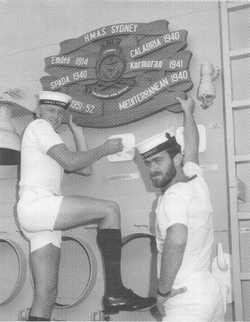- Author
- Periodical, Sea Power Centre
- Subjects
- History - general, Ship design and development
- Tags
-
- RAN Ships
- None noted.
- Publication
- June 2010 edition of the Naval Historical Review (all rights reserved)
Battle honours
Another important naming principle adopted from the Royal Navy was the practice of reusing names in later generations of ships in order to build tradition and foster a sense of esprit de corps among ships’ companies. Today, for example, the RAN has in commission the fourth ships to bear the name Sydney and Parramatta and the third ships named Stuart and Anzac. All vessels that inherit a name previously carried by a former RAN warship carry forth the Battle Honours won by their Australian predecessors, which are listed on an ornately carved wooden board normally displayed in the vicinity of a ship’s gangway.

There have of course been exceptions to these general naming conventions. Throughout the Australian Navy’s early history a number of ships were acquired from the RN that retained their original British names. Some of these names have been used in later classes of Australian warships to perpetuate the deeds performed by the officers and men who served in them. These include names such as Vampire, Voyager, Vendetta, Stalwart and Success to name but a few.
Guidance on current RAN naming principles can be found in Defence instructions, which reflect a strong emphasis on promoting links between the Navy and the Australian community, with a preference to maintain a uniquely Australian identity. Joseph Cook’s early recognition of Australia’s indigenous people has also been continued with several RAN warships bearing Aboriginal names, notably the Anzac class frigates Arunta (II) and Warramunga (II).
Many factors are taken into consideration when selecting names for a new class of ship and this begins when the Chief of Navy (CN) calls for naming recommendations from the Naval History Section (NHS), Sea Power Centre – Australia. The first consideration when compiling potential names is the type and number of vessels being introduced into service. In general terms, surface combatants and patrol boats may be named after Australian cities, towns or districts while submarines may carry names with a uniquely Australian connection.
In the case of the Collins class submarines the names of famous Australian World War II naval personalities were used for the first time to acknowledge their outstanding service. Amphibious ships are usually named after Australian amphibious operations, battles or contiguous seas while mine warfare vessels may be named after rivers and bays. Smaller craft such as tugs adopt the names of Australian flora and fauna. All vessels may bear the name of a previous ship of a comparable class as is the case with Kanimbla (II) and Manoora (II).
Achieving a balanced distribution of names among Australia’s states and territories and reviewing the various representations received by CN from civil communities and ex-service groups to have ships carry a particular name is an integral part of the naming process. All of these representations receive careful consideration, irrespective of whether they have a specific link with the Australian community or not, and are appraised on the actual suitability of the name proposed and the service record and history of ships that may have carried the name previously.
The NHS then prepares a comprehensive brief for CN on proposed names, their history and the level of public interest. This brief normally contains names well in excess of the number actually required in order to provide CN with a variety of naming options. CN will then exercise the privilege of his position to make a final decision or, alternately, he may call for a further submission from the NHS.
Once CN selects the names, his recommendations are forwarded through the Minister for Defence and the Prime Minister to His Excellency the Governor General for final approval.
The planned acquisition of three new Air Warfare Destroyers (AWD) and two new Amphibious Ships, coupled with the acquisition of the Armidale class patrol boats has seen a variety of former names selected to return to use as well as one or two new ones. For example, the AWDs will be named Hobart (III), Brisbane (III) and Sydney (V) while the amphibious ships will be named Canberra (III) and Adelaide (III).
Unfortunately there will always be more names available than there are ships to carry them and the decision to select a particular name is seldom an easy one. Currently all vessels planned for the future RAN fleet have now been named, but for those readers interested in the histories of some of our famous and not so famous ships please visit the RAN Ship Histories page on the Sea Power Centre – Australia web site: http://www.navy.gov.au/history/sea-power-centre




